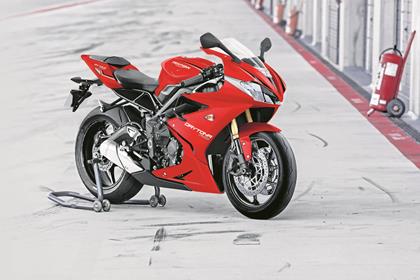Are Triumph targeting a 2020 return for the Daytona with a Moto2 developed 765 engine?
Triumph’s headlong entrance into the biggest motorcycle racing spotlight on Earth in 2019, as the Hinckley firm become the official engine supplier for Moto2, poses an immediate and obvious question: Where’s the Daytona 765?
With their superb Daytona 675 unable to meet Euro4 compliance, the model will vanish from UK dealer showrooms during 2018 as customers desperate for the bike’s sublime marriage of inline triple engine, taut chassis, attractive aesthetics and addictive soundtrack rush to grab the last available new bikes.
In any other year since the birth of the supersport sector back in 1987, there would be a brand new, faster, sharper, more powerful and more technology-loaded version waiting in the wings to replace it – but not this time. The supersport market has been declining at an alarming rate over the last decade, and while some manufacturers are bravely grasping the nettle and holding on – like Yamaha with their updated 2017 YZF-R6 – others are simply letting their supersport bikes fade away. Honda, Suzuki and Kawasaki have failed to make any serious updates in recent years, and their supersport screamers are all rumoured to be facing the final curtain. Even the iconic GSX-R750 is under threat, while Suzuki still say they can’t imagine it dying out.
So what does all this mean for the best of the current crop – the Daytona? Surely Triumph can’t make such a wildly bold statement of intent in Moto2 if there’s no intention to build a new Daytona? The firm is already putting in the laps on a test mule for Moto2 using their own chassis, which could take them right to the very edge of product planning development. They’ve got the engine, the chassis, the electronics package and the ability, so it’s a sure thing, right?
Well, maybe not. “The emotional desire is there for the product, but it’s getting it over the business threshold that’s the hard part,” says Paul Lilly, General Manager of Triumph Motorcycles in the UK. Far from being a ransom for the model, this is a cold commercial reality that can’t be ignored. Yamaha’s R6 and Honda’s CBR600RR have both been selling as few as 100 units in the UK in recent years, and while Yamaha’s new model means they will rally to nearer 300 for 2017, it’s not enough to merit the phenomenal costs of R&D for an all-new model. But that doesn’t mean it’s never going to happen.
“Are we actively in production with something to come out next year called the Daytona? Honestly, no,” says Triumph’s Head of Brand Management, Miles Perkins. “Is there a longer-term opportunity for it? Yes, there is.”
It’s all about demand, and if enough current and potential Daytona owners can convince Triumph that sales will be significant, then there’s a chance it could go into production.
“If we could prove the demand, then of course we’ll do it,” said Steve Sargent, Triumph’s Chief Product Officer. “With the excitement we have around Moto2, we would be foolish not to consider it as a possibility.” That burden of viability is crucial though. And the process of developing and homologating a new Daytona is nowhere near as simple as it looks from the building blocks Triumph already have in place thanks to their Street Triple RS and their Moto2 test mules.
The only apparent certainty right now is that the Daytona 765 is not waiting in the wings for 2018, nor 2019. The very earliest possibility looks like 2020, the year after their Moto2 engine debut – but that will only get the production green light if it can gather the critical mass needed to convince Triumph they won’t be pouring millions into a project that can’t reward the investment. They need to be bombarded with requests to replace their sublime Daytona 675 with a Moto2 developed Daytona 765. And those requests need to be backed up with sales. You know what you need to do.
![]()
Daytona wish list
• Moto2-bred 765 inline triple
• 135bhp and 60ftlb torque
• Traction control and cornering ABS
• Semi-active electronic suspension
• Full TFT dash and rider modes
• Quickshifter and autoblipper
• 168kg single-seat Moto2 replica


